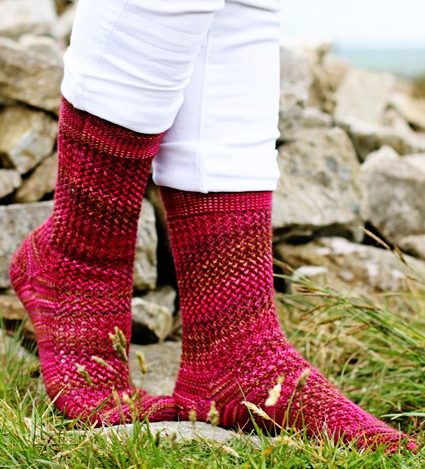

|
|
|

When I was in Art College we spent several months working on a single theme. Starting with a simple object using different media, angles and levels of abstraction many different pieces of work were produced. Sometimes when I finish a pattern I feel that that I'm not finished exploring; that the stitch pattern combination or technique has more to give. This is how I felt with my shawl, Penrose Tile. It used a combination of lace, garter stitch and short rows that I wanted to explore further; soon Penrose Toes were born! I love the squishy, soft effect you get from garter stitch so I thought that they would be just perfect to cushion the toes and heels on a sock. I used my favourite short row method in garter stitch: German Short Rows. They're easy and fast to create. If you're used to standard wrap & turn short row methods it will feel a little different working these. |
||
|
SIZE |
|
|
FINISHED MEASUREMENTS |
|
MATERIALS
Notions |
|
GAUGE |
|
PATTERN NOTES |
|
Worked from the toe up, short rows are used to shape the toe. When the foot is finished, increases are worked for a gusset. The heel is worked using short rows and then the gusset stitches are again decreased. You can create a perfect-fitting sock and you can control the amount of yarn you use. Begin by splitting the skein in half, one half for each sock. Choose foot size based on the circumference of your foot and then knit the length of the foot to suit your own foot. If you want a longer leg length just work until your half skein of yarn has been used up. Provisional Cast On Slp wyif: Slip 1 stitch purlwise with yarn in front. German Short Rows When you encounter this ‘double stitch' on another row, knit the two strands together, as a single stitch. Here's a tutorial. When you make your short row turn, the ‘double stitch' you create is the first stitch of your next short row. So basically it sits inside your short row gap. However with the standard wrap method that wrap sits outside the short row gap. When you are working the second layer of ‘double stitches' at the toe and heel you will create a different looking stitch that is bulkier than the first double stitch. Elastic Bind Off |
|
DIRECTIONS Join working yarn. Setup row [WS]: Knit one row with working yarn. Short Row 5 [RS]: Slp wyif, lift yarn over needle, knit to first double stitch, knit double stitch tog, turn work. Setup rnd: Slp wyif, lift yarn over needle, knit to last double stitch, knit double stitch tog, knit final st, pm for start of rnd, undo Provisional Cast On, placing 28[30, 32] sts on second side of needle, knit to end of rnd, knitting double stitch tog as you pass. 56[60, 64] sts.
Foot The first 28[30, 32] sts on the first side of the needle form the sole, and the rem 28[30, 32] sts form the instep. Next Rnd: K30[32, 34] sts, work Lace Pattern across the next 24[26, 28] sts, k2. Gusset Increases: Next rnd, increase: K28[30, 32] sts, M1L, work Instep sts in pattern, M1R. 2 sts inc'd. Work these two rnds 8[9, 10] more times, 74[80, 86] sts; 28[30, 32] heel sts, 46[50, 54] instep sts including gusset sts.
Short row Heel Short Row 1 [RS]: K27[29, 31], turn work. Short Row 5 [RS]: Slp wyif, lift yarn over needle, knit to first double stitch, knit double stitch tog, turn work. Rep Short Rows 7 & 8 7[8, 9] more times. Next Rnd: Slp wyif, lift yarn over needle, knit to last double stitch, knit double stitch tog, work in patt to end of rnd, remove marker, k1. This is the new start of round. Place marker or rearrange sts as desired. Slip final heel st to instep sts for gusset decreases.
Gusset decreases: Slip first and last st from instep back to heel. This moves start of rnd by one st back to its original position. You will now have 28[30, 32] sts on each side. Leg Cuff |
|
FINISHING |
| ABOUT THE DESIGNER |
|
Carol Feller is a knitwear designer and teacher living in Cork, Ireland with a family of boys and a big old lazy dog. Carol has designed over 160 patterns: self-published on her website, Interweave Knits, Brooklyn Tweed and others, or as part of one of her three books. |
|
Pattern & images © 2015 Carol Feller. Contact Carol |